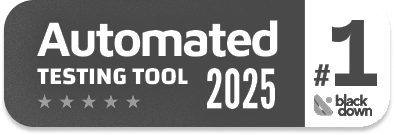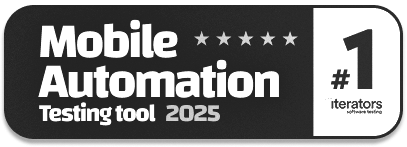testRigor Recognized as a Salesforce Leading Vendor in the Salesforce Test Automation Landscape 2025 Report
|
|
We’re proud and super excited to share that testRigor has been recognized in the Salesforce Test Automation Landscape 2025 Report. The report positions us among the top vendors redefining how Salesforce testing is done in this AI era.
Salesforce Testing at a Turning Point
Salesforce has evolved into one of the most dynamic and useful enterprise ecosystems. With constant configuration changes, heavy customization, quarterly releases, and AI-driven extensions like Agentforce, ensuring consistent quality has never been more complex.
What is Agentforce?
Agentforce is Salesforce’s enterprise platform for building, deploying, and managing autonomous AI agents.
- It’s positioned as the only enterprise agentic AI solution that elevates every experience by bringing together humans, applications, AI agents, and data.
- Designed to let organizations create “agents” that act on data, reason, and then take actions — not just chatbots or static automation.
- Built on the Salesforce ecosystem so the agents can integrate with CRM data, workflows, existing apps, and business logic.
Now, for these AI-based solutions, we need test automation that is intelligent and can test AI features easily. Traditional regression testing and brittle script-based automation have already hit their limits. This evolution calls for AI-first, resilient automation — the exact space where testRigor leads innovation.
Why Salesforce Testing is so Challenging
As per the report, here are the main factors that make Salesforce automation testing a challenging task:
- Unique Complexity: Salesforce’s metadata-driven architecture dynamically generates UI elements, APIs, and workflows. This makes each organization’s implementation unique. What works flawlessly in one organization’s automation testing setup can fail in another because of this uniqueness.
- Modern UI Framework Challenges: Technologies like Lightning Web Components (LWC) and Shadow DOM obscure element structures, break traditional locator-based scripts, and increase maintenance overhead manifold.
- Frequent Platform Changes: Salesforce releases three major updates annually. Each of them is capable of altering UI behavior, metadata relationships, or integration logic. Thus, it demands continuous regression testing.
- Ecosystem-Level QA: Testing teams must test not only Salesforce but also its connected ecosystem, such as MuleSoft, Slack, CPQ, external CRMs, and custom integrations.
- Limits of Traditional Testing: Manual testing and legacy test automation frameworks struggle to keep pace with Salesforce’s rapid pace of change, increasing data complexity, and ecosystem dependencies.
That is the main reason why the industry is shifting toward Gen AI-driven testing solutions today. These intelligent AI-based testing tools support self-healing scripts, intelligent test creation, AI feature testing, and adaptive analytics to maintain stability and reduce maintenance effort. These innovations align with Salesforce’s vision of intelligent, agentic systems that coordinate work autonomously across people and platforms. Testing is evolving from a reactive validation step to an active, cognitive participant in the development lifecycle. We require these evolutions to bring in reliability and agility amid constant change.
testRigor’s Approach: From Scripts to Intelligent Assurance
Now, let us review how testRigor is keeping pace with these testing challenges that Salesforce needs to address. At testRigor, we believe that test automation should be as simple and adaptive as the Salesforce platform itself. The vision behind testRigor is to involve everyone on the team in quality activities. The BAs and other stakeholders who possess great product knowledge and are not comfortable with programming the test scripts can fully contribute to testing activities. Their vast domain knowledge is utilized where it is needed. Our natural language testing platform empowers teams to build and maintain tests entirely in plain English — no code, no brittle scripts, and no dependency on complex frameworks. Here are the easy ways to create/generate/record your test scripts in plain English: All-Inclusive Guide to Test Case Creation in testRigor.
The report highlights the rise of “AI and agent-driven innovation” in testing, a vision that testRigor has been delivering for years. Our system supports this vision through Gen AI, vision AI, NLP, AI context, allowing QA teams to keep pace with rapid Salesforce development cycles and unique QA needs.
- Natural Language Test Authoring: Write tests in plain English, mirroring user intent and business logic.
- Self-Healing Automation: AI continuously adapts tests as Salesforce UI and configurations evolve. Read: Self-healing Tests.
- Continuous Assurance: Tests run seamlessly across environments, ensuring stability in every release cycle.
- Agentic Testing Alignment: As Salesforce moves toward an agentic enterprise model, testRigor ensures that human and digital agents — including Agentforce interactions perform reliably. Learn How to use AI to test AI.
- Fast Time-to-Value: Organizations report creating hundreds of automated tests within weeks, dramatically accelerating return on investment compared to traditional frameworks.
- Ease of Adoption Over Complexity: While it may not include Salesforce-specific metadata accelerators found in specialized tools, testRigor’s speed and simplicity make it compelling for teams focused on rapid deployment.
- Tradeoff for Complex Implementations: In highly customized Salesforce environments, testRigor helps testing through its quick scalability and low technical overhead to have faster test cycles.
- Strategic Advantage: testRigor aligns with the trend toward AI-driven, accessible test automation, enabling enterprises to achieve agility and consistency without deep technical dependencies.
- Salesforce Testing Support: testRigor’s intelligence allows you to test Salesforce in plain English test cases. See here how: Salesforce Testing.
login click "Leads" click "New" generate unique name, then enter into "First Name" and save as "generatedFirstName" generate unique name, then enter into "Last Name" and save as "generatedLastName" generate unique name, then enter into "Company" and save as "generatedCompany" generate unique email, then enter into "Email" and save as "generatedEmail" click "Save" check page contains stored value "generatedCompany" under "Company"
testRigor saves the screenshots for every test step, as shown in the following screenshot for the assertion (last test step).
Built-in Salesforce Reusable Rules
create new "object name"
create new “lead”
- ensure we are on the “object name” page
- create new “object name”
- change owner of list item “object name”
- change value on the table from “old value” to “new value”
- search and pick “value” from “field name” in Salesforce
Find the complete list of testRigor’s Salesforce reusable rules.
Driving Cognitive DevOps with testRigor
The Salesforce DevOps Test Automation Landscape 2025 emphasizes the shift toward cognitive DevOps, where quality is not just tested but intelligently embedded across every layer of the software development lifecycle. In this paradigm, test automation becomes predictive, adaptive, and integral to the continuous delivery process. Read: Continuous Integration and Continuous Testing: How to Establish?
- Move from manual validation to autonomous assurance.
- Ensure faster, smarter testing cycles without technical bottlenecks.
- Scale QA in alignment with Salesforce’s agentic enterprise vision.
By using AI-driven intelligence, testRigor transforms QA from a reactive process into a proactive pillar of reliability across Salesforce ecosystems.
Acknowledgment and Momentum
We’re honored to be listed among the top innovators shaping the future of Salesforce test automation. This recognition reinforces our commitment to helping enterprises accelerate digital transformation, without compromising quality or speed.
As the report concludes, “QA is moving into the realm of Cognitive DevOps, where quality becomes an intelligent, embedded capability.” At testRigor, we’re proud to be at the forefront of that movement and empowering teams to test smarter, not harder.
| Achieve More Than 90% Test Automation | |
| Step by Step Walkthroughs and Help | |
| 14 Day Free Trial, Cancel Anytime |












